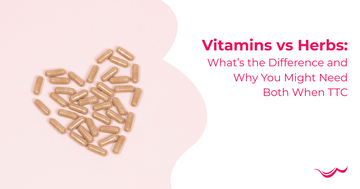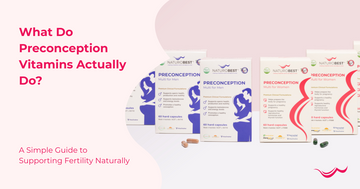Preconception vs Prenatal Vitamins: What’s the Difference?
by Nikki Warren on May 02, 2022

Preconception
During the 4-month preconception period, the aim for women is boosting nutrient levels. In particular, folate, vitamin B12, choline, iodine, iron and zinc which are crucial nutrients to a healthy conception and pregnancy.
Preconception is vital to make sure that both the egg and sperm are of highest quality possible. This is important because the quality of the egg and sperm will determine the health of the baby.
A preconception plan needs to be followed for at least 3-4 months, ideally longer such as 1-2 years. It is recommended that you put aside more time to prepare for a baby if you have other health conditions. This will take the time pressure off conceiving and allow your body to be in its healthiest state for pregnancy.
Adequate nutritional status is absolutely essential in your preconception care plan. Nutrients are the building blocks for healthy eggs and sperm.
You may need additional supplements on top of a preconception multi. Especially in the case of iron if you have a deficiency. A blood test, specifically a ferritin test which is your iron stores, will give you more information about your iron status.
It is recommended that you optimise your iron status at the start of preconception. This is important so that you have time to increase your iron stores before falling pregnant.
If you are chronically iron deficient, this could indicate other problems such as poor absorption or excessive blood loss. Poor absorption of iron could be caused by conditions such as coeliac disease or IBD. Excessive blood loss may be caused by heavy periods or bleeding in the digestive tract. If you have been iron deficient for a long time, you should discuss further testing to rule out these problems.
The aim for men should be creating healthy sperm. The 4 crucial nutrients here are vitamins B12, C, E and zinc. However, a comprehensive men's preconception multi should contain nutrients that help support healthy testosterone levels and sperm health. Extra antioxidants such as alpha lipoic acid, which recycles CoQ10, are helpful here.
Inflammation and metabolic factors can impair sperm health. Inflammation can be caused by toxin/chemical exposure in the workplace, alcohol intake, smoking and low exercise. Metabolic factors such as suboptimal glucose levels and cholesterol can impair sperm health as well. Dietary and lifestyle changes are essential to minimising these factors for sperm health.
First Trimester of Pregnancy
When it comes to pregnancy and breastfeeding, your needs vary throughout. The crucial time for folate supplementation is one month prior to conception. Then until the 6th week of pregnancy when the neural tube closes.
A woman should consume at least 500mcg of folate daily at this time. Quatrefolic is a type of active folate that has superior absorption to other types of folate. It is also 150 times more expensive than folic acid. So it will only be found in premium supplement brands like NaturoBest.
Studies have shown that vitamin B12 may be just as important as folate in the prevention of birth defects. It is often found in a 1:1 ratio to folate. In the first trimester, up to 85% of women suffer from morning sickness.
This can impact her ability to tolerate some supplements including iron, which often makes a woman feel more nauseous. Other nutrients that can make a woman feel nauseous include high dose zinc and B vitamins. Prenatal Trimester One was designed with the sensitive tummy of a newly pregnant woman in mind. It can be taken until her morning sickness subsides.
This is usually around week 14 to 16 of pregnancy. Sometimes a woman may struggle to swallow capsules at a time when her gag reflex is sensitive. This is where a capsule rather than a tablet comes in handy. This is so you can open up the capsule and add to a smoothie or yoghurt if needed.
It is important that we try to make it as easy as possible for pregnant women that suffer from morning sickness. It can be a really difficult time for these women to be able to reach their nutrient requirements. It is important that pregnant women feel supported through their morning sickness journey. It is important they have adequate guidance and assistance to meet their nutrient needs.
Second and Third Trimester of Pregnancy
During the last half of pregnancy (from about week 16) a woman’s blood volume doubles increasing her nutrient requirements significantly. This is a stage when she needs a prenatal multi-vitamin that meets her increased demands.
Breastfeeding
Breastfeeding mother's know they need adequate amounts of assistance during this time. She needs to be able to meet her own needs and also supply her baby with healthy, nutrient-dense breast milk. In fact, her iodine requirement during breastfeeding is higher than it was when she was pregnant! Prenatal Trimester 2 & 3 Plus Breastfeeding contains the recommended daily intake of iodine during breastfeeding of 270mcg.
The Difference Between Preconception and Prenatal Multi-vitamins
There is no difference between preconception vitamins and pregnancy vitamins designed for the last half of pregnancy and breastfeeding. One boosts nutrient stores, the other meets nutrient stores. The unique requirements of the first trimester are different. Therefore, there is a need for a separate formula for this special time of a woman’s pregnancy.




